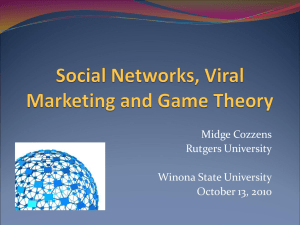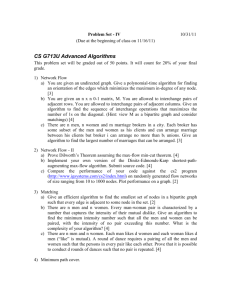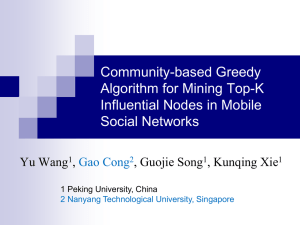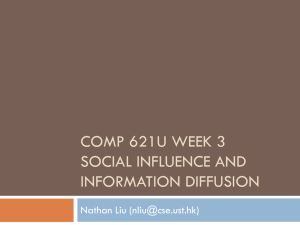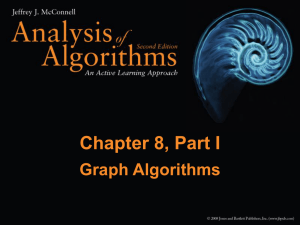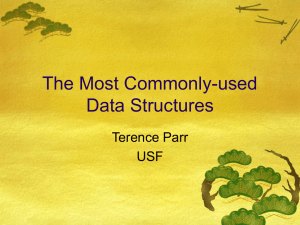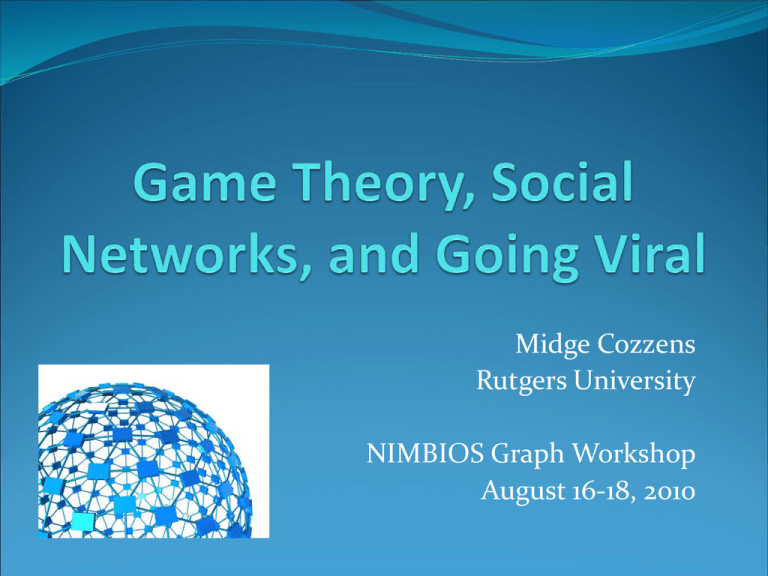
Midge Cozzens
Rutgers University
NIMBIOS Graph Workshop
August 16-18, 2010
What is Viral Marketing?
Start off with a small group of individuals and spread
by “word-of-mouth”, email, etc.
Initial individual tells two of his friends and they tell…
Not necessarily selling a product, but attempts to
change behavior or condition, to activate!
Spread of viruses, disruptions etc.
through an ecosystem.
• Two people start singing
• Next their friends join in
• By the end of the song, the
whole bar is singing Mariah
Carey’s Fantasy…true story
Small-Scale Behavioral Viral Spreading
Graph Theory - Viral spread
Contagious
Progressive &
Nonprogressive
Weighted edges
“Target” node
Game Theory
• Prisoners’ Dilemma Example
• Two choices
• Confess
• Don’t Confess
• Payoff
• Prisoners’ Outcomes
• Payoff Table
• Zero Sum and Nonconstant Sum Games
• Nash Equilibrium
Don’t Confess
Confess
Confess
(10,10)
(0,20)
Don’t Confess
(20,0)
(1,1)
• Apply Game Theory to Viral Marketing
• Players - individuals
• Find Best Strategies for Changing
Behaviors
Game Theory and Graph Theory
Graph
Vertices = individuals
Edge (i,j) exists if i and j have a relationship
Weights on edges = strength of relationship
Directed graph
Directed edge, or arc (k,g)
exists if k has influence
over g
Varying Applications
Strategies of political parties in getting voters
to vote for their candidate. REU student Jim
Manning showed that the optimal strategy
for the Republicans in 2008 was to go after
moderates first then bring in the
conservatives. Had they done that they
would have taken 60% of the vote and beat
Obama. Instead they brought in Sarah
Palin to get the conservative base in place.
Another Application
Change the behavior of college students
concerning unprotected sex. REU student
Jordan Mitchell wrote a paper to be
published in a sociology journal showing
strategies to convince students to use
protection. She used real data and
measured parameters governing use such as
attractiveness, drinking, multiplicity of
partners, etc.
Another Application
Volvo car dealers have decided to concentrate
on online marketing to sell cars across the
country. Ajay Matapalli, REU student,
developed an optimal progressive strategy
for marketing where the dealers gained
significantly and the incentives were far
more lucrative then would have been just
walking in off the street.
Incentive Model
Individual gain is represented by v(xh) where xh
represents an individual (or in terms of a graph, a
specific node).
The subsequent factor is the gain (loss) that the
individual receives from his or her peers owning the
product as well. The inspiration for separating the
individual and collective gain came from H. Peyton
Young’s work. A simple example would be if my
neighbor had sneakers, then I would gain the
enjoyment of being able to run with him if I
purchased sneakers.
Incentive Model
u(xh , xj) is a binary function, where xj is any node in
the graph G not equal to xh, such that if there exists an
edge between xh and xj , and xj owns the product, then
the function equals 1; if there doesn’t exist an edge or xj
doesn’t own the product, then let the function equal 0.
r = constant that represents the benefit of a node,
which you are connected to having the product.
Incentive Model
Edge weights (the strength of the connection between
two people); contained in the set (0, 1].
w(xh , xj) be a function, where xj is any node in the
graph G not equal to xh, such that if there exists an
edge between xh and xj , then the output value is the
weight of the edge; if there doesn’t exist an edge, then
the output value is 0.
This accounts for the fact that all connections which
you have to other people are not equal; thus the edges
with aren’t as strong don’t influence the buyer node as
much.
Total Effects in the Model
The total effects of viral marketing is the sum all the
benefits from each peer connection
∑ u(xh , xj) w(xh , xj)r
The graph theory comes into play here because when
forming this function we are concerned with the
converted node who is reaching out to the new
potential customers nodes (its neighbors).
q = constant that represents a value that will normalize
the weight of the edge to use in our final equation.
y(xh , xo) = the weight of the edge coming from the
previously converted node if there is one; if there is no
previously converted node, then this function equals
The final incentive equation is:
I(xh) = Incentive for Individual xh
I(xh) = z(xh) – v(xh) – y(xh , xo)q - [ ∑ u(xh , xj) w(xh , xj)r ]
The incentive must at least be equal to the gap between
the cost of the product to the individual and the gain and
ease of the buying it.
Overall Gain Model
G(xh) Overall Gain to Individual xh
G(xh) = v(xh) + [ ∑ u(xh , xj) w(xh , xj)r ] + y(xh , xo)q
Profit Model
B = cost of marketing
I = incentive
M = cost of manufacture or equivalent
T = retail price
k = number expected to purchase product
C(xh) Cost to Company for xh
C(xh) = I(xh) + B/k + M/k
P(xh) Profit for Company from xh
P(xh) = T – C(xh)
Payoff Matrix
Data for table
Consumer Research
Past history data
CDC data for spread of disease,
Public and World Health data on the effectiveness of
innoculations
Tipping Point and Equilibrium
Graph Theory Questions
Find the k most influential nodes to market
to:
In general, identifying the k most
influential nodes is NP-hard.
A natural greedy algorithm exists which is a
1−1/e−ε approximation for selecting a target
set of size k, using probabilistically
determined simulations.
Tuberculosis Network
SW Oklahoma 2002
Spread of Viruses and Innoculation
Social Networks relative to virus spreading most
often look like stars linked together as in the next
slide which shows a portion of the first to set to
contract TB and their contacts.
Current procedures focus on inoculating the
vulnerable -- often the very young and the very old.
Network analysis tells us that it may be smarter,
and more efficient, to focus on the spreaders -those with many contacts to many groups.
Possible Research Directions
Find classes of graphs where finding the k-most
influential nodes can be done in polynomial time.
Consider ways of subdividing the social network into
subgraphs where the k-most influential nodes are
easy to find.
What type of dominating sets in a graph should one
look for?
How does the connectivity of a social network
influence spread?
What other connectivity parameters make sense?
Research Directions
What other connectivity parameters make sense?
Once the most influential node(s) are targeted, how
do you reach other (or all) nodes in the graph?
• Find a Hamiltonian path – hard!
• Find an Eulerian path – easy if connected and vertices
have only 2 odd degree vertices;
• Partition the graph into connected components with
one target node in each component and add or subtract
edges so Eulerian path can be found in each.
Find an euler path
Remove 3 edges
Fleury’s Algorithm to get path
References
Influential Nodes in a Diffusion Model for Social Networks (David Kempe, Jon Kleinberg, Eva
Tardos):
http://www-rcf.usc.edu/~dkempe/publications/influential-nodes.pdf
Diffusion on Social Networks (Matthew O. Jackson):
http://economiepublique.revues.org/docannexe1777.html
The Diffusion of Innovations in Social Networks (H. Peyton Young):
http://www.brookings.edu/~/media/Files/rc/reports/1999/05fixtopicname_young/diffusion.pdf
Information Diffusion in Online Social Networks (Lada Adamic):
http://www.eecs.harvard.edu/~parkes/nagurney/adamic.pdf
Diffusion in Complex Social Networks (Dunia Lopez-Pintado):
http://www.sisl.caltech.edu/pubs/diffusion.pdf
Social Networks and the Diffusion of Economic Behavior (Matthew O. Jackson):
http://www.stanford.edu/~jacksonm/yer-netbehavior.pdf
Cascading Behavior in Networks: Algorithmic and Economic Issues (Jon Kleinberg):
http://www.cs.cornell.edu/home/kleinber/agtbook-ch24.pdf

